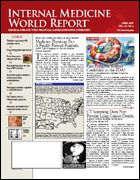Drug-Eluting Stent Alert Issued: Get Back to Basics
Continued Dual Antiplatelet Therapy Crucial
The Society for Cardiovascular Angiography and Interventions (SCAI), the world’s largest organization in the field, has issued an alert about the risk of late thrombosis in patients who have received a drug-eluting stent (DES).
IMWR
This new alert comes on the heels of the FDA’s hearings in December 2006 (see , January 2007) and the FDA Circulatory Systems Devices Panel’s statement about the small but significant risk of stent thrombosis reported in patients with DES.
IMWR
“This is a wake-up call to get back to basics and not to use drug-eluting stents as a default strategy in busy clinical settings when other strategies might work better and more safely with the indiv-idual patient,” lead author John Hodgson, MD, chief of cardiology at St. Joseph’s Hospital and Medical Center, Phoenix, and past president of SCAI, told .
New research indicates that the use of DES is associated with a 2% increased rate of thrombosis at 1 to 4 years after stent implantation. The complication occurred with the 2 DESs available—sirolimus (Cypher)-eluting and paclitaxel (Taxus)-eluting stents.
The SCAI alert includes the following recommendations:
• All candidates for a stent should meet published criteria for percutaneous coronary intervention
• The decision to use a DES, bare-metal stent, or surgical revascularization should be made on an individual basis after the risks and benefits of each therapy have been evaluated and discussed with the patient
• Each patient must be evaluated for the likelihood of compliance with long-term dual antiplatelet therapy and for the potential risks with such treatment
• Use of intravascular ultrasound screening for calcification and careful lesion preparation are encouraged, and careful attention should be paid to stent implantation techniques
• After DES implantation, patients who meet FDA-approved guidelines should receive dual antiplatelet therapy for ≥3 months if a sirolimus-eluting stent is used or ≥6 months if a paclitaxel-eluting stent is used
• Patients not at high risk for bleeding should continue on dual antiplatelet therapy for 12 months; until more data are analyzed, patients at increased risk for stent thrombosis should, after a review of risks and benefits, be considered for >12 months of dual antiplatelet therapy
• The decision to discontinue dual antiplatelet therapy, temporarily or permanently, should take into account the risks and benefits to the individual patient in light of the new information about late stent thrombosis and previously known problems related to bleeding
• All decisions regarding the risks and benefits of therapies and the need for dual antiplatelet therapy should be made in conjunction with the patient and be fully documented in the medical records
• Patients should be assured that when a DES is chosen after careful consideration of individual needs, it remains an effective method for treating disabling symptoms associated with coronary heart disease.
IMWR
“It is critically important to be certain that each patient will be able to maintain dual antiplatelet therapy for 12 months following treatment with a DES. In patients not expected to comply with this regimen, for economic or other reasons, strong consideration should be given to avoiding a DES,” Alice Jacobs, MD, professor of medicine at Boston University, director of the Cardiac Catheterization Laboratory and Interventional Cardiology at the Boston Medical Center, and past president of the American Heart Association, told .
“This alert by the members of SCAI will serve to educate patients and physicians about the importance of continuing dual antiplatelet therapy following implantation of a DES,” she added. The SCAI alert is available at www.scai.org
